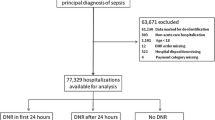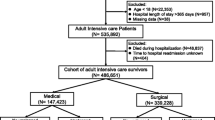Abstract
OBJECTIVE: To compare the use of do-not-resuscitate (DNR) orders in African-American and white patients using a large, multisite, community-based sample.
MEASUREMENTS: Our sample included 90,821 consecutive admissions to 30 hospitals in a large metropolitan region with six nonsurgical conditions from 1993 through 1995. Demographic and clinical data were abstracted from medical records. Admission severity of illness was measured using multivariate risk-adjustment models with excellent discrimination (receiver-operating characteristic curve areas, 0.82–0.88). Multiple logistic regression analysis was used to determine the independent association between race and use of DNR orders, adjusting for age, admission severity, and other covariates.
MAIN RESULTS: In all patients, the rate of DNR orders was lower in African Americans than whites (9% vs 18%; p<.001). Rates of orders were also lower (p<.001) among African Americans in analyses stratified by age, gender, diagnosis, severity of illness, and in-hospital death. After adjusting for severity and other important covariates, the odds of a DNR order remained lower (p<.001) for African-Americans relative to whites for all diagnoses, ranging from 0.38 for obstructive airway disease to 0.71 for gastrointestinal hemorrhage. Results were similar in analyses limited to orders written by the first, second, or seventh hospital day. Finally, among patients with DNR orders, African Americans were less likely to have orders written on the first hospital day and more likely to have orders written on subsequent days.
CONCLUSIONS: The use of DNR orders was substantially lower in African Americans than in whites, even after adjusting for severity of illness and other covariates. Identification of factors underlying such differences will improve our understanding of the degree to which expectations for care differ in African American and white patients.
Similar content being viewed by others
References
Danis M, Southerland LI, Garrett JM, et al. A prospective study of advance directives for life-sustaining care. N Engl J Med. 1991;324:882–8.
Hakim RB, Teno JM, Harrell FE Jr, et al. Factors associated with do-not-resuscitate orders: patients’ preferences, prognoses, and physicians’ judgments. Ann Intern Med. 1996;125:284–93.
Teno JM, Hakim RB, Knaus WA, et al. Preferences for cardiopulmonary resuscitation: physician-patient agreement and hospital resource use. J Gen Intern Med. 1995;10:179–86.
Ayanian JZ, Udvarhelyi IS, Gatsonis CA, Pashos CL, Epstein AM. Racial differences in the use of revascularization procedures after coronary angiography. JAMA. 1993;269:2642–6.
Ford E, Cooper R, Castaner A, Simmons B, Mar M. Coronary arteriography and coronary bypass survey among whites and other racial groups relative to hospital-based incidence rates for coronary artery disease: findings from NHDS. Am J Public Health. 1989;79:437–40.
Gittelsohn AM, Halpern J, Sanchez RL. Income, race, and surgery in Maryland. Am J Public Health. 1991;81:1435–41.
Johnson PA, Lee TH, Cook EF, Rouan GW, Goldman L. Effect of race on the presentation and management of patients with acute chest pain. Ann Intern Med. 1993;118:593–601.
Kahn KL, Pearson ML, Harrison ER, et al. Health care for black and poor hospitalized Medicare patients. JAMA. 1994;271:1169–74.
Kasiske BL, Neylan JF III, Riggio RR, et al. The effect of race on access and outcome in transplantation. N Engl J Med. 1991;324:302–7.
Peterson ED, Wright SM, Daley J, Thibault GE. Racial variation in cardiac procedure use and survival following acute myocardial infarction in the Department of Veterans Affairs. JAMA. 1994;271:1175–80.
Satariano ER, Swanson GM, Moll PP. Nonclinical factors associated with surgery received for treatment of early-stage breast cancer. Am J Public Health. 1992;82:195–8.
Tunis SR, Bass EB, Klag MJ, Steinberg EP, Variation in utilization of procedures for treatment of peripheral arterial disease: a look at patient characteristics. Arch Intern Med. 1993;153:991–8.
Haas JS, Weissman JS, Cleary PD, et al. Discussion of preferences for life-sustaining care by persons with AIDS: predictors of failure in patient-physician communication. Arch Intern Med. 1993;153:1241–8.
Kellogg FR, Ramos A. Code status decision-making in a nursing home population: processes and outcomes. J Am Geriatr Soc. 1995;43:113–21.
O’Brien LA, Grisso JA, Maislin G, et al. Nursing home residents’ preferences for life-sustaining treatments. JAMA. 1995;274:1175–9.
Gramelspacher GP, Zhou XH, Hanna MP, Tierney WM. Preferences of physicians and their patients for end-of-life care. J Gen Intern Med. 1997;12:346–51.
Garrett JM, Harris RP, Norburn JK, Patrick DL, Danis M. Life-sustaining treatments during terminal illness: who wants what? J Gen Intern Med. 1993;8:361–8.
Hofmann JC, Wenger NS, Teno J, et al. Choices of seriously ill patients about cardiopulmonary resuscitation: correlates and outcomes. Am J Med. 1996;100:128–37.
Phillips RS, Wenger NS, Teno J, et al. Choices of seriously ill patients about cardiopulmonary resuscitation: correlates and outcomes. Am J Med. 1996;100:128–37.
Rosenfeld KE, Wenger NS, Phillips RS, et al. Factors associated with change in resuscitation preference of seriously ill patients. Arch Intern Med. 1996;156:1558–64.
Shepardson LB, Youngner SJ. Speroff T, et al. Variation in the use of do-not-resuscitate orders in patients with stroke. Arch Intern Med. 1997;157:1841–7.
Wenger NS, Pearson ML, Desmond KA, et al. Epidemiology of do-not-resuscitate orders: disparity by age, diagnosis, gender, race, and functional impairment. Arch Intern Med. 1995;155:2056–62.
Jayes RL, Zimmerman JE, Wagner DP, Knaus WA. Variations in the use of do-not-resuscitate orders in ICUs: findings from a national study. Chest. 1996;110:1332–9.
Zimmerman JE, Knaus WA, Sharpe SM, et al. The use and implications of do not resuscitate orders in intensive care units. JAMA. 1986;255:351–6.
The 1994 AHA Guide. Chicago, Ill: American Hospital Association; 1994.
Rosenthal GE, Quinn L, Harper DL. Declines in hospital mortality associated with a regional initiative to measure hospital performance. Am J Med Qual. 1997;12:103–12.
Gordon HS, Harper DL, Rosenthal GE. Racial variation in predicted and observed in-hospital death: a regional analysis. JAMA. 1996;276:1639–44.
Rosenthal GE, Harper DL. Cleveland health quality choice: a model for community-based outcomes assessment. Jt Comm J Qual Improv. 1994;20:425–44.
Wenger NS, Oye RK, Teno JM, et al. Patient age, race and perceived health status are associated with preferences for comfort care. Clin Res. 1992;40:620A. Abstract.
Levy DR. White doctors and black patients: influence of race on the doctor-patient relationship. Pediatrics. 1985;75:639–43.
McKinley ED, Garrett JM, Evans AT, Danis M. Differences in end-of-life decision making among black and white ambulatory cancer patients. J Gen Intern Med. 1996;11:651–6.
Blendon RJ, Aiken LH, Freemean HE, Corey CR. Access to medical care for black and white Americans: a matter of continuing concern. JAMA. 1989;261:278–81.
Hayward RA, Shapiro MF, Freemean HE, Corey CR. Inequities in health services among insured Americans. Do working-age adults have less access to medical care than the elderly? N Engl J Med. 1988;318:1507–12.
Lewin-Epstein N. Determinants of regular source of health care in black. Mexican, Puerto Rican, and non-Hispanic white populations. Med Care. 1991;29:543–57.
Newacheck PW, Hughes DC, Stoddard JJ. Children’s access to primary care: differences by race, income, and insurance status. Pediatrics. 1996;97:26–32.
Becker LB, Han BH, Meyer PM, et al. Racial differences in the incidence of cardiac arrest and subsequent survival. The CRC Chicago Project. N Engl J Med. 1993;329:600–6.
Castaner A, Simmons BE, Mar M, Cooper R. Myocardial infarction among black patients: poor prognosis after hospital discharge. Ann Intern Med. 1988;109:33–5.
Author information
Authors and Affiliations
Additional information
Dr. Rosenthal is a Research Associate, Health Services Research and Development Service, Department of Veterans Affairs, and was a recipient of a Picker/Commonwealth Scholar’s Award from the Commonwealth Fund when this work was conducted.
Rights and permissions
About this article
Cite this article
Shepardson, L.B., Gordon, H.S., Ibrahim, S.A. et al. Racial variation in the use of do-not-resuscitate orders. J GEN INTERN MED 14, 15–20 (1999). https://doi.org/10.1046/j.1525-1497.1999.00275.x
Issue Date:
DOI: https://doi.org/10.1046/j.1525-1497.1999.00275.x




